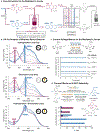Quinone-mediated hydrogen anode for non-aqueous reductive electrosynthesis
- PMID: 37604186
- PMCID: PMC10777621
- DOI: 10.1038/s41586-023-06534-2
Quinone-mediated hydrogen anode for non-aqueous reductive electrosynthesis
Abstract
Electrochemical synthesis can provide more sustainable routes to industrial chemicals1-3. Electrosynthetic oxidations may often be performed 'reagent-free', generating hydrogen (H2) derived from the substrate as the sole by-product at the counter electrode. Electrosynthetic reductions, however, require an external source of electrons. Sacrificial metal anodes are commonly used for small-scale applications4, but more sustainable options are needed at larger scale. Anodic water oxidation is an especially appealing option1,5,6, but many reductions require anhydrous, air-free reaction conditions. In such cases, H2 represents an ideal alternative, motivating the growing interest in the electrochemical hydrogen oxidation reaction (HOR) under non-aqueous conditions7-12. Here we report a mediated H2 anode that achieves indirect electrochemical oxidation of H2 by pairing thermal catalytic hydrogenation of an anthraquinone mediator with electrochemical oxidation of the anthrahydroquinone. This quinone-mediated H2 anode is used to support nickel-catalysed cross-electrophile coupling (XEC), a reaction class gaining widespread adoption in the pharmaceutical industry13-15. Initial validation of this method in small-scale batch reactions is followed by adaptation to a recirculating flow reactor that enables hectogram-scale synthesis of a pharmaceutical intermediate. The mediated H2 anode technology disclosed here offers a general strategy to support H2-driven electrosynthetic reductions.
© 2023. The Author(s), under exclusive licence to Springer Nature Limited.
Conflict of interest statement
Figures




References
-
- Cardoso DSP, Šljukić B, Santos DMF & Sequeira CAC Organic electrosynthesis: From laboratorial practice to industrial applications. Org. Process Res. Dev 21, 1213–1226 (2017).
-
- Pletcher D & Walsh FC Industrial Electrochemistry, 2nd edition. pp. 298–311 (Kluwer, 1990).
-
- Leech MC, Garcia AD, Petti A, Dobbs AP & Lam K Organic electrosynthesis: from academia to industry. React. Chem. Eng 5, 977–990 (2020).
-
- Sherbo RS, Delima RS, Chiykowski VA, MacLeod BP & Berlinguette CP Complete electron economy by pairing electrolysis with hydrogenation. Nat. Catal 1, 501–507 (2018).
Grants and funding
LinkOut - more resources
Full Text Sources

